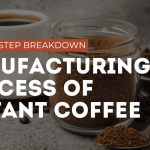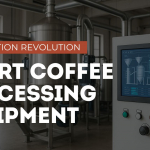Introduction: The Crossroads of Growth and Capacity
For specialty coffee businesses experiencing steady growth, there comes a pivotal moment when commercial roasting equipment no longer meets production demands. This transition point represents both significant challenges and extraordinary opportunities. Scaling up from commercial to industrial coffee roasters isn’t merely about purchasing larger equipment—it’s a comprehensive operational evolution that affects every aspect of your business.
Many roasting operations find themselves caught in a challenging middle ground: current equipment is running at maximum capacity with multiple daily batches, yet investing in industrial equipment represents a substantial capital expenditure that requires careful planning. The right approach to this transition can dramatically increase production efficiency, reduce per-unit costs, and open new market segments previously inaccessible due to volume limitations.
This comprehensive guide explores the key considerations, technical requirements, and strategic approaches to successfully navigate the transition from commercial to industrial coffee roasting operations.
Ready to Scale? Key Indicators It’s Time to Transition
Before committing to the significant investment that industrial roasting equipment represents, it’s essential to recognize the clear signs that your business is truly ready for this transition:
Production at Maximum Capacity
- Multiple back-to-back roasting sessions becoming the norm rather than the exception
- Extended operating hours or additional shifts added to meet demand
- Consistent inability to fulfill orders within desired timeframes
Market Growth Indicators
- Increasing wholesale accounts requiring larger, consistent batch volumes
- New market opportunities that can’t be pursued due to production limitations
- Expanding geographic distribution requiring greater production volume
Financial Readiness
- Consistent profitability over multiple quarters or years
- Available capital or financing options for significant equipment investment
- Strong cash flow capable of absorbing temporary disruptions during transition
Operational Indicators
- Process standardization already implemented and documented
- Quality control systems firmly established
- Management team with capacity to oversee expansion project
When multiple indicators align, it’s likely time to seriously consider scaling up your roasting operation. However, the transition should be approached strategically rather than reactively.
Commercial vs. Industrial Roasters: Beyond Capacity Differences
The distinctions between commercial and industrial coffee roasters extend far beyond their batch capacity. Understanding these differences is crucial for successful implementation and operation:
Heat Transfer Mechanisms and Consistency
Commercial Roasters:
- Typically use conduction and convection heating in smaller drum designs
- May experience minor temperature fluctuations between batches
- Heat distribution may be less uniform in larger batches
Industrial Roasters:
- Employ sophisticated heat delivery systems with precise temperature controls
- Maintain temperature consistency across much larger batch sizes
- Often incorporate multiple temperature probes throughout the roasting chamber
- May use advanced heat recirculation systems for efficiency
- Feature more powerful burners with faster recovery times between batches
Control System Sophistication
Commercial Roasters:
- Basic digital or analog controls
- Limited data logging capabilities
- Manual adjustment of primary parameters (time, temperature)
- Simpler profile management systems
Industrial Roasters:
- Advanced PLC (Programmable Logic Controller) systems
- Comprehensive data logging and analysis
- Multiple parameter monitoring (temperature, airflow, drum speed, etc.)
- Automated profile management with fine adjustment capabilities
- Remote monitoring and control options
- Integration with production management software
Automation Capabilities and Labor Requirements
Commercial Roasters:
- Largely manual operation requiring constant attention
- Limited automation for loading and unloading
- Operator typically manages one machine at a time
- Batch-to-batch consistency depends heavily on operator skill
Industrial Roasters:
- Extensive automation from green coffee handling to packaging
- Conveyor systems for bean transport between processes
- One operator can potentially oversee multiple aspects of production
- Automated cleaning cycles and maintenance alerts
- Recipe-driven operations ensuring consistency regardless of operator
Energy Source Considerations
Commercial Roasters:
- Typically gas-powered with standard utility connections
- Lower overall energy consumption
- Simpler exhaust requirements
Industrial Roasters:
- May use gas, electric, or hybrid energy systems
- Significantly higher energy demands requiring dedicated utility services
- Potential for heat recovery systems to improve efficiency
- May require 3-phase power installations
- Options for alternative fuel sources in some models
Facility Requirements
Commercial Roasters:
- Can often operate in retail or light commercial spaces
- Standard ventilation and emissions systems
- Modest floor load requirements
- Limited ancillary equipment footprint
Industrial Roasters:
- Require dedicated industrial space with appropriate zoning
- Reinforced flooring to support heavier equipment weight
- Sophisticated ventilation and emissions control systems
- Significant space requirements for ancillary equipment
- Climate-controlled environments for consistent operation
- Noise consideration and potential soundproofing needs
Quality Control Challenges
Commercial Roasters:
- Visual inspection of most batches possible
- Sample roasting often done on production equipment
- Manual logging and tracking systems usually sufficient
Industrial Roasters:
- Need for automated sampling systems
- Dedicated quality control laboratory with specialized equipment
- Sophisticated tracking systems with barcode or RFID technology
- Statistical process control methodologies
- Need for defined tolerance ranges and corrective action protocols
Production Planning and Capacity Calculations
Proper production planning is essential when transitioning to industrial-scale roasting. This section provides guidance on calculating actual production capacity and planning for efficient operations:
Calculating True Production Capacity
Unlike commercial roasting where capacity is often expressed simply in terms of batch size, industrial roasting capacity must account for multiple factors:
Batch Capacity × Cycles Per Hour × Operating Hours × Efficiency Factor = Daily Production Capacity
For example:
- 120 kg batch capacity
- 2.5 cycles per hour (including loading, roasting, cooling, and unloading)
- 8 hour operating day
- 85% efficiency factor (accounting for cleaning, maintenance, and changeovers)
120 kg × 2.5 cycles × 8 hours × 0.85 = 2,040 kg daily production capacity
Batch Scheduling Strategies
Industrial roasting operations typically implement one of several batch scheduling approaches:
- Product-Based Scheduling: Grouping similar coffee types or profiles to minimize roaster adjustments
- Client-Based Scheduling: Organizing production around specific client orders
- Just-In-Time Production: Aligning roasting with shipping schedules to maximize freshness
- Continuous Production: Maintaining consistent output of core products with supplemental specialty batches
Labor Planning for Industrial Operations
Scaling up requires rethinking labor allocation:
- Operator-to-Machine Ratio: Typically 1:1 for commercial operations, but can shift to 1:3 or more for industrial setups
- Specialized Roles: Creating dedicated positions for quality control, maintenance, and logistics
- Shift Considerations: Evaluating single shift vs. multiple shift operations
- Training Requirements: Developing comprehensive training programs for operating sophisticated equipment
ROI and Break-Even Analysis for Industrial Roasting Equipment
A thorough financial analysis should precede any major equipment investment:
Capital Expenditure Components
- Primary roasting equipment cost ($150,000-$500,000+ depending on capacity)
- Facility modifications (ventilation, power, structural)
- Ancillary equipment (conveyors, destoners, packaging systems)
- Installation and commissioning costs
- Initial training and setup expenses
Operational Cost Changes
- Energy consumption differences
- Maintenance requirements and costs
- Labor cost redistribution
- Green coffee storage and handling costs
- Packaging material volume discounts
- Potential waste reduction savings
Break-Even Calculation Methodology
To determine the break-even point for your investment:
- Calculate the total investment cost including all equipment and facility modifications
- Determine the per-unit cost savings between commercial and industrial roasting
- Estimate the increased production volume enabled by new equipment
- Calculate: Break-Even Point = Total Investment ÷ (Per-Unit Savings × Annual Production Volume)
ROI Considerations Beyond Direct Cost Savings
- Market expansion opportunities
- New product development capabilities
- Improved consistency and quality
- Enhanced brand positioning
- Reduction in operational stress and overtime costs
Common Pitfalls and Mistakes During Scaling Transitions
Awareness of frequent challenges can help your operation avoid costly mistakes:
Underestimating Facility Requirements
- Insufficient power capacity for equipment demands
- Inadequate ventilation leading to compliance issues
- Floor loading capacity not meeting equipment weight
- Space constraints limiting efficient workflow
Operational Readiness Failures
- Insufficient training before equipment commissioning
- Lack of documented standard operating procedures
- Inadequate quality control systems for higher volumes
- Failure to establish preventive maintenance protocols
Supply Chain Complications
- Green coffee storage capacity not matching production increase
- Logistics systems unprepared for higher volume movements
- Packaging material supply chains not scaled appropriately
- Insufficient finished product storage space
Market Alignment Issues
- Production capacity exceeding actual market demand
- Sales channels not developed before capacity expansion
- Pricing strategies not adjusted for new cost structures
- Brand positioning misaligned with production scale
Scaling Strategies: Phased Approach vs. Complete Overhaul
Two primary approaches exist for scaling roasting operations:
Phased Transition Approach
This gradual scaling strategy involves:
- Installing mid-sized equipment alongside existing operations
- Gradually shifting production to new equipment
- Expanding capacity in predetermined increments
- Retaining smaller equipment for specialty or sample batches
Advantages:
- Lower initial capital requirements
- Reduced operational disruption
- Opportunity to adjust plans based on early implementation experience
- Easier staff training and adaptation
Disadvantages:
- Extended transition period
- Potentially higher total cost over time
- Space inefficiencies during transition
- Possible inconsistencies between equipment during overlap
Complete Overhaul Approach
This comprehensive approach involves:
- Full replacement of existing equipment with industrial systems
- Complete reconfiguration of production space
- Implementation of all ancillary systems simultaneously
- Temporary production outsourcing during transition if necessary
Advantages:
- Shorter overall transition period
- Optimized facility layout from the beginning
- Potential cost savings through integrated installation
- Immediate access to full production capacity
Disadvantages:
- Higher initial capital requirements
- Greater operational disruption
- Increased implementation risk
- Steeper learning curve for staff
Case Studies: Successful Transitions to Industrial Roasting
Case Study 1: Urban Roaster Collective
Initial Situation:
- Three 25kg commercial roasters running 12 hours daily
- 1,500 kg weekly production capacity at maximum utilization
- Quality inconsistencies between batches and machines
- Limited ability to take on new wholesale accounts
Transition Approach:
- Implemented a phased transition starting with a 120kg Probat industrial roaster
- Retained one commercial roaster for small-batch specialty coffees
- Installed automated green coffee handling and packaging systems
- Developed dedicated quality control lab with sample roaster
Results:
- Production capacity increased to 6,000 kg weekly on single shift operation
- Per-pound roasting cost reduced by 37%
- Staffing reorganized from 4 roasting operators to 2 operators plus 1 QC specialist
- Energy efficiency improved by 22% per pound of coffee
- New wholesale accounts increased revenue by 65% within 18 months
Case Study 2: Mountain Peak Coffee Exporters
Initial Situation:
- Multiple 15kg roasters handling specialty export orders
- Production limited to 800 kg weekly
- Inconsistent results between different machines
- Inability to bid on larger international contracts
Transition Approach:
- Complete overhaul with installation of 240kg Loring industrial roasting system
- Implementation of automated quality control systems
- Development of comprehensive production management software
- Complete reconfiguration of production facility
Results:
- Production capacity increased to 8,000 kg weekly
- Secured major international contracts previously unattainable
- Carbon emissions reduced by 30% despite production increase
- Quality consistency improved dramatically with measurable metrics
- New equipment ROI achieved in under 24 months
Ancillary Equipment Considerations
Industrial roasting operations require supporting equipment often overlooked in transition planning:
Pre-Roasting Systems
- Green coffee storage silos with climate control
- Destoning equipment to remove foreign objects
- Weighing and blending systems for consistent batch preparation
- Conveyor systems for bean transport to roaster
Post-Roasting Equipment
- Industrial cooling systems separate from the roaster
- Destoners (again) to remove any stones after roasting
- Chaff collection systems with appropriate fire prevention
- Automated packaging lines calibrated for different container types
- Finished product storage systems with inventory management
Quality Control Equipment
- Sample roasters calibrated to match production profiles
- Color measurement devices for roast consistency verification
- Moisture analyzers for green and roasted coffee
- Density measurement equipment for quality verification
- Cupping laboratory with water filtration and temperature control
Facility Support Systems
- Emissions control equipment meeting local regulations
- Fire suppression systems designed for coffee roasting hazards
- Energy management systems optimizing consumption
- Compressed air systems for pneumatic controls
- Water treatment for cooling and cleaning operations
Maintaining Quality Consistency During Transition
Quality control becomes increasingly critical at industrial scale:
Establishing Baseline Measurements
- Document existing roast profiles with detailed measurements
- Establish quality standards and acceptable variance ranges
- Create comprehensive cupping protocols for production validation
- Develop sensory reference standards for quality benchmarking
Profile Translation Strategies
- Work with equipment manufacturers to translate existing profiles
- Implement staged testing to align new equipment performance
- Develop correlation methods between different roasting systems
- Create detailed documentation of all profile adjustments
Implementing Statistical Process Control
- Define critical control points throughout the production process
- Establish sampling methodologies appropriate to production volume
- Implement measurement systems with statistical analysis
- Develop corrective action protocols for out-of-specification results
Training and Communication
- Develop comprehensive training programs for all production staff
- Create clear communication channels between production and quality control
- Implement regular calibration sessions for sensory evaluation
- Establish feedback loops for continuous improvement
Environmental Considerations and Compliance
Industrial-scale roasting introduces new environmental and regulatory requirements:
Emissions Control Requirements
- Volatile Organic Compound (VOC) regulations and control options
- Particulate matter filtering systems
- Smoke reduction technologies
- Afterburner or catalytic oxidizer requirements
- Continuous emissions monitoring systems
Energy Management
- Power factor correction for electrical systems
- Heat recovery opportunities from roasting process
- Energy use monitoring and optimization
- Alternative energy integration possibilities
- Thermal efficiency strategies
Waste Management
- Coffee chaff collection and potential repurposing
- Green coffee waste management
- Packaging material recycling systems
- Water conservation and treatment
- Composting opportunities for organic waste
Regulatory Compliance
- Air quality permits and reporting requirements
- Food safety certification considerations
- Occupational safety and health requirements
- Fire code compliance for industrial processing
- Zoning and land use permits
Expert Guidance Through Critical Transitions
Navigating the transition from commercial to industrial coffee roasting represents a significant challenge even for experienced coffee professionals. Our specialized consulting services provide comprehensive support throughout this critical evolution:
Pre-Transition Planning Services
- Capacity requirement analysis and equipment specification
- Facility assessment and modification planning
- Financial modeling and ROI projection
- Timeline development and critical path identification
- Vendor evaluation and selection assistance
Implementation Support
- Project management throughout equipment installation
- Profile translation and quality consistency assurance
- Staff training and standard operating procedure development
- Quality control system implementation
- Production workflow optimization
Post-Implementation Optimization
- Efficiency analysis and improvement recommendations
- Quality control system refinement
- Maintenance program development
- Process documentation and standardization
- Continuous improvement implementation
Conclusion: Strategic Transition as Competitive Advantage
The transition from commercial to industrial coffee roasting represents far more than a simple equipment upgrade—it’s a comprehensive transformation of your coffee business. When executed strategically, this evolution creates significant competitive advantages through improved efficiency, enhanced quality consistency, and expanded market access.
By carefully assessing readiness indicators, thoroughly understanding the technical and operational differences between commercial and industrial equipment, and implementing a well-structured transition plan, roasting businesses can minimize disruption while maximizing the benefits of increased scale.
The most successful transitions treat this process as a strategic initiative rather than merely an equipment purchase, integrating production planning, facility considerations, quality control systems, and environmental compliance into a comprehensive approach that positions the business for sustainable growth.
With expert guidance through this complex process, coffee roasting operations can transform scaling challenges into powerful opportunities for business expansion and market leadership.




